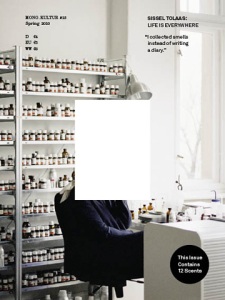 My readings on the social construction of smells, scent, and olfaction brought me, again, to the astonishing work of the Norwegian artist, activist, and perfumer Sissel Tolaas. In a recent interview with the journal mono.kultur she talks about her motivations to analyze, recreate, and work with smell and scent. According to her, smell as a relational medium allows recognition as another source of knowledge that co-creates identity: scents can manipulate human beings in order to “establish or to maintain their class identity“ (Tolaas in mono.kultur #23, p. 11). In a footnote: also her interpretation of communism resembling the “stale air of imposed uniformity” (page 36 in “If there ever was (a book of extinct and impossible smells)” by Robert Blackson, Art Editions North/Cornerhouse, 2008) convinces that smell can be understood as a “socio-spatial construct and also a narrative” (Tolaas in mono.kultur #23, p. 27).
My readings on the social construction of smells, scent, and olfaction brought me, again, to the astonishing work of the Norwegian artist, activist, and perfumer Sissel Tolaas. In a recent interview with the journal mono.kultur she talks about her motivations to analyze, recreate, and work with smell and scent. According to her, smell as a relational medium allows recognition as another source of knowledge that co-creates identity: scents can manipulate human beings in order to “establish or to maintain their class identity“ (Tolaas in mono.kultur #23, p. 11). In a footnote: also her interpretation of communism resembling the “stale air of imposed uniformity” (page 36 in “If there ever was (a book of extinct and impossible smells)” by Robert Blackson, Art Editions North/Cornerhouse, 2008) convinces that smell can be understood as a “socio-spatial construct and also a narrative” (Tolaas in mono.kultur #23, p. 27).
In contrast, her work is “about tolerance“ (ibid., p. 13). It is about training how to revise culturally established understandings of smell in order to alter perceptions of what is good or bad. These aspects are not new – for instance, Classen et al. (1994) or Corbin (1986) have elaborated on this – but the activities and activism behind it, actually, is.
According to these viewpoints, the creative work on perfumes can indeed be phrased as materialistic and capitalistic: scents are created in order to attract consumers, to convince a consumer to spend money, and to generate significant returns on investment. It is about property and the illusion/illumination of decoration through purchased objects.
However, these reiterations allow new ways of thinking. Beyond the aspects of manipulation through perfume – i.e. the coverage of the personal identity with branded perfumes – a qualification of creators that work beyond the edge of repetitively accused consumerism, thus in the area of niche perfumery, is legitimate. I list two discourses about what the term niche means according to this way of thinking. A shift applies to the production and consumption of perfumes but other sectors potentially as well .
First, the reasoning of making niche perfumes shifts from the emphasis of a distinct artistic articulation through scents (the dominant discourse) to the well-structured and strategically-planned coordination of brand identity/originality in order to allow a holistic understanding by the knowledgeable consumer. The quality and characteristics of niche(d) scents are important aspects during the motivation to create and establish a niche brand. However, the survival on the market is a much more intricate question of strategy and financial planning. Thus, the (over-) emphasis of artisanry in making individualistic scents is paralleled by a strategic organization that is common in large manufacturers.
Second, the reasoning of using niche perfumes shifts from being different (from other perfume users) to questioning and opening up a different recognition, self-representation, and evaluation. Thus, the use of non-mainstream personalized objects is surely a sphere of activity for understatement but, moreover, an area to reshape identity, stress camouflage, question fixity, and repetitively allow a new demand of perception by other people.
Comments are closed.